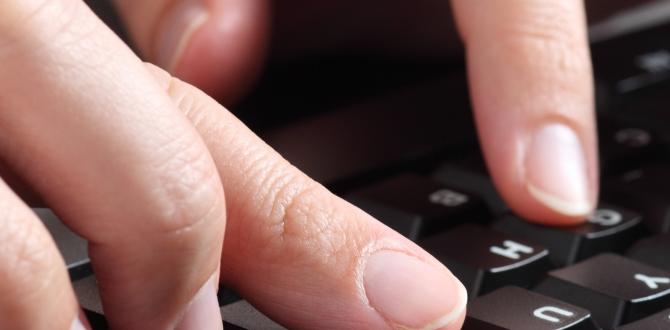Don’t let dry firing damage your nail gun or your workpiece! This guide shows you exactly how to prevent it, ensuring your tool lasts longer and your projects look professional. We’ll cover simple techniques and best practices to keep your nail gun firing only when it should.
Hey there, DIYers and woodworkers! Jack Shaffer here, your go-to guy for all things nailing. If you’ve ever heard that startling “snap!” without a nail coming out, you’ve experienced dry firing. It’s a common frustration for many, especially when you’re just starting out with a new nail gun. It can be noisy, annoying, and even damage your tool over time. But don’t worry! Avoiding this annoyance is actually quite straightforward.
With a few simple habits and a little understanding of how your nail gun works, you can ensure every trigger pull results in a perfectly placed nail. We’ll walk through everything you need to know, keeping it simple and actionable. Get ready to make dry firing a thing of the past and nail your projects with confidence!
Table of Contents
Why Dry Firing is a Problem
Dry firing might seem like a minor inconvenience, but it’s more than just an empty sound. It’s like revving your car’s engine while it’s in neutral – it doesn’t achieve anything useful and can put unnecessary wear on your equipment. For nail guns, this means:
- Damage to the Driver Blade: The driver blade is the part that strikes and drives the nail. When there’s no nail to hit, the blade hits the nose of the gun. This repeated impact can dull, bend, or even break the driver blade over time.
- Wear on the O-rings and Seals: Nail guns use air pressure to drive nails. Dry firing can cause these internal seals to become stressed and wear out faster than they should, potentially leading to air leaks and reduced power.
- Bouncing or Damaging the Workpiece: In some cases, especially with pneumatic nailers when the contact trip is engaged without a nail, the moving parts can still generate enough force to lightly impact or even mar the surface of your workpiece.
- Reduced Tool Lifespan: Consistently dry firing your nail gun means it’s putting stress on its components without doing the job you bought it for. This can shorten its overall operational life.
- Wasted Time and Frustration: Every dry fire means you have to stop, check your nail supply, and refocus. It breaks your workflow and can be incredibly irritating when you’re trying to get a project done.
Understanding these potential issues is the first step to preventing them. Thankfully, avoiding dry firing is all about awareness and a few simple techniques.
Understanding Your Nail Gun and How It Fires
Before we dive into avoiding dry firing, let’s quickly touch on how most nail guns work. There are a few main types, and their firing mechanisms can slightly differ, but the core principle is the same: an impact drives a nail.
Pneumatic Nail Guns (Air-Powered)
These are the most common type for heavy-duty tasks. They use compressed air from an air compressor. When you press the trigger and the safety contact tip (also called the “nose” or “trigger safety”) is pressed against your workpiece, a valve opens, and air rapidly drives the driver blade forward to fire a nail.
Crucially, pneumatic nailers typically have two mechanisms that need to work together:
- The Trigger: This releases the air.
- The Safety Contact Trip: This mechanism must be depressed against a surface for the gun to fire.
Depending on the model, the trigger might activate the air release only when the safety tip is depressed, or it might be a sequential trip (one trigger pull to set the nail, another to fire) or a bump fire (hold the trigger down and bump the nose against the work to fire repeatedly). Regardless of the trigger mode, if there are no nails loaded, the driver blade will strike the internal mechanisms instead of a nail. We’ll talk more about selective trip levers later, as they play a role in preventing accidental firings.
Cordless Nail Guns (Battery-Powered)
These use a battery to power a motor. The motor either spins to drive a large spring (like an electric nailer) or powers a small combustion process using fuel cells (in gas/cordless models) or a capacitor to drive the nail. Like pneumatic guns, they also have a safety contact tip that must be pressed. When the trigger is pulled and the tip is depressed, the mechanism fires a nail.
Electric Nail Guns (Corded)
These plug into a wall outlet and use electricity with a solenoid or motor mechanism to drive the nail. They also rely on the safety contact tip and a trigger for operation. The firing action can sometimes feel a bit different, but the principle of needing a nail present remains the same.
The key takeaway here is that nearly all operational nail guns have a safety contact tip that needs to be engaged with a surface for the tool to fire. This is a safety feature, but it’s also a crucial part of how we can prevent dry firing.
The Contact Trip and Trigger Interaction
Most modern nail guns have a “contact trip” safety mechanism. This is the part at the very end of the gun’s nose. You have to press this against your material before pulling the trigger to fire a nail. This is a fantastic safety feature to prevent accidental nail discharge when you’re just moving the tool around.
However, if you press this contact tip down on a piece of wood (or other surface) and then pull the trigger when the magazine is empty, you’ll dry fire. It’s the most common way for it to happen, especially when you’re starting a new run of nails or if you’re not paying close attention to your nailer’s remaining ammo.
Essential Techniques to Avoid Dry Firing
Now, let’s get to the good stuff – how to make sure your nail gun only fires when there’s a nail ready to go. These are tried-and-true methods that will save your tool and your sanity.
1. Always Check Nail Load Before Firing
This is the golden rule. Get into the habit of glancing at your nail magazine every single time before you pull the trigger. Seriously, make it a ritual.
- Visual Scan: Once you’ve finished a line of nails, or even just a few, take a quick look at the nose of your nail gun where the nails feed in. Can you see nails in the channel?
- Featherlight Touch: Before you even think about pressing the trigger, give a tiny, almost imperceptible lift to the safety contact tip. This often allows you to see if there’s at least one more nail ready to go without actually firing.
This habit will quickly become second nature and is the most effective way to prevent dry firing.
2. Listen to Your Nail Gun
Your nail gun has a distinct sound when it fires a nail, and it often sounds slightly different when it dry fires. It’s usually a sharper, more metallic “snap” or “clang” versus a more solid “thwack” or “bang” when a nail is driven.
- Develop an Ear: Spend some time listening consciously to your nail gun in action. Pay attention to the sound when you know there are plenty of nails loaded.
- Recognize the Dry Fire Sound: Once you’ve heard it dry fire once or twice (hopefully not by accident!), you’ll begin to recognize that empty sound more easily. If you hear it, stop immediately and check your load.
This takes a little practice, but building this auditory awareness can add another layer of protection against dry firing.
3. Use the Selective Trip Lever Wisely (If Available)
Many modern nail guns come with a selective trip lever or switch. This allows you to choose between different firing modes: bumping (also called “contact actuation”) or sequential firing.
- Sequential Firing: This is often the safer mode for beginners and for precision work. You pull the trigger first, and then you “bump” the nose against the material to fire a nail. This means you’re intentional about each nail.
- Bump Firing: You hold the trigger down, and then bump the nose against the material to fire nails rapidly. This is great for speed but also makes accidental dry firing more likely if you’re not attentive.
Tip: If you’re not actively trying to speed through a project, consider setting your nail gun to sequential firing mode. This requires two distinct actions for each nail (trigger pull, then contact), making it harder to accidentally fire an empty chamber.
Even in bump-fire mode, the principle of checking your load before you start bumping is essential. A momentary lapse in attention while bump firing can lead to several dry fires in quick succession.
4. Perform Regular Maintenance
A well-maintained nail gun is less prone to issues, including those that might make dry firing more likely. Keeping your tool clean and lubricated ensures its moving parts are functioning smoothly.
- Lubrication: For pneumatic tools, use the recommended synthetic nailer oil. Add a few drops before each use as per the manufacturer’s instructions. This keeps the driver blade and O-rings happy. Some cordless/electric models also have lubrication requirements.
- Cleaning: Keep the nose and magazine area clean and free of debris. Wood dust and shavings can sometimes interfere with the nail feed mechanism, making it harder to see the nail load or even causing it to jam.
- Check for Leaks: If your pneumatic nailer is hissing air after you’ve finished firing, or if the air pressure seems to drop quickly, you might have a seal issue. Addressing these promptly can prevent more significant problems down the line. For guidance on maintenance, check out resources like this from OSHA’s Construction Safety page on hand and power tools, which emphasizes proper tool care: OSHA – Hand and Power Tools.
Regular maintenance ensures your nail gun is operating at its best, reducing the chances of unexpected behavior, including dry firing.
5. Understand Your Safety Nose Design
The design of the safety contact tip can sometimes play a role. Some nose designs have a more prominent or easily accessible area to see into, while others are more recessed. Familiarize yourself with your specific nail gun’s nose.
- Clear Visibility: If your nose design allows for easy visual inspection, use it! It’s the most direct method.
- Leverage Small Movements: If visibility is poor, you can sometimes gently lift the nose just enough to break contact with the surface. If you can then see the driver blade sitting flush with the loading channel, chances are there’s no more nails.
Don’t force the nose if it feels stuck, but a slight pivot or lift can sometimes give you the visual cue you need.
6. Pay Attention to Nail Feed Issues
If your nail gun is starting to jam frequently, or if nails aren’t feeding smoothly from the magazine into the firing chamber, these are red flags. Poor feeding can often lead to thinking you have nails left when you don’t.
- Clear Jams Promptly: Don’t let jams linger. Clear them as soon as they happen according to your tool’s manual.
- Inspect the Feed Mechanism: Look for bent nails, debris, or damage that might be preventing smooth operation.
- Magazine Alignment: Ensure the magazine is properly aligned and that the nails you’re using are the correct size and type for your gun. Using the wrong nails is a recipe for jams and potential damage.
A nail gun that reliably feeds nails will make it easier to accurately gauge when you’re running low.
7. Take Breaks and Stay Focused
This might sound simple, but fatigue is a major enemy of focus. When you’re tired, you’re more likely to make mistakes, like forgetting to check your nail load.
- Work in Sessions: If you have a long day of nailing ahead of you, break it up. Take short breaks to rest your hands and clear your head.
- Minimize Distractions: Try to work in an environment with fewer distractions. If people are around, let them know you need to concentrate.
- Mindful Nailing: Approach each nail as an intentional act. This mindfulness will naturally lead you to check your nail supply before each trigger pull.
Focusing on the task at hand is crucial for safety and efficiency. When you’re in the zone, you’re less likely to experience frustrating issues like dry firing.
Tips by Nail Gun Type
While the general principles apply to all nail guns, there are slight nuances depending on the power source.
| Nail Gun Type | Specific Dry-Fire Prevention Tips |
|---|---|
| Pneumatic (Air-Powered) |
|
| Cordless (Battery-Powered) |
|
| Electric (Corded) |
|
No-Nail Lockout Features
Many modern nail guns, especially cordless and electric models, are equipped with a “no-nail lockout” feature. This is essentially an internal mechanism that detects when the magazine is empty and prevents the driver blade from firing. When this feature is active, you’ll likely hear a different sound, or the trigger will simply feel unresponsive when it’s time to reload. Refer to your nail gun’s manual to understand if your tool has this feature and how to identify when it’s engaged. It’s your built-in protection against dry firing for many newer tools!
Troubleshooting Common Dry Fire Scenarios
Even with the best practices, sometimes you’ll find yourself wondering why you dry fired. Here are a few common scenarios and how to address them:
Scenario 1: Just Finished a Strip of Nails
- Cause: You were so focused on the pattern of nails that you didn’t realize the last nail was fired.
- Solution: This is where visual inspection or the “feathering” technique (gently lifting the nose) before the trigger pull becomes your best friend. Reload the magazine immediately.
Scenario 2: Nail Jammed, and I Thought I Had More
Sometimes, a nail can jam partway in the feed mechanism or nose. You might think there are still nails left in the magazine, but the jam prevents the next one from reaching the firing position.
- Cause: A jammed nail misrepresents the count of nails available in the magazine.
- Solution: Safely disconnect power/air, clear the jam according to your manual, and then double-check the magazine’s contents before attempting to fire again. If jams are frequent, it’s time to investigate the feed mechanism or the nails you’re using.




